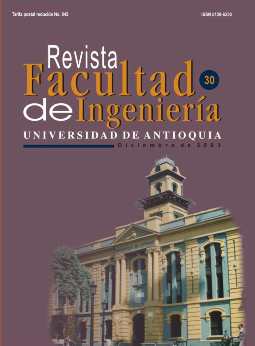La transformación de un vehículo eléctrico, con la regulación con VTC (variador de tensión continua), en un vehículo con inversor de frecuencia y motor eléctrico asíncrono
DOI:
https://doi.org/10.17533/udea.redin.327322Palabras clave:
vehículo eléctrico, regulación con VTC, inversor de frecuencia, motor eléctrico asíncronoResumen
El trabajo presenta la metodología y las condiciones que deben cumplirse para transformar los vehículos de corriente continua, con regulación de la velocidad de marcha por VTC (chopper), en vehículos accionados por corriente alterna con la regulación mediante inversor y motor eléctrico de tracción asíncrono. Tanto en el primer sistema como en el segundo la regulación de la velocidad se hace mediante el autómata programable.
En el primer sistema la regulación de la velocidad es posible mediante el control por impulsos del chopper, mientras que en el segundo la regulación se realiza con la modificación tanto de la tensión como de su frecuencia.
Las siguientes funciones del autómata programable no se cambian: el control y el seguimiento de las instalaciones auxiliares del interruptor principal, el control y seguimiento de los contactores de línea y también el diseño de los indicadores de la velocidad, la corriente y la tensión. Otras características del autómata programable se cambian totalmente: el control de los tiristores o los transistores, las informaciones con respecto a la corriente, se elimina una serie de componentes y aparatos y además se pueden montar otros aparatos directamente en el inversor.
En conclusión, el paso del sistema de accionamiento con máquina eléctrica de corriente continua, y la regulación de la velocidad de marcha con variador de tensión continua VTC (chopper), al sistema de accionamiento con máquina de corriente alterna y la regulación mediante el inversor, puede realizarse de una manera relativamente fácil después de un análisis de las funciones de las instalaciones de control y regulación.
Descargas
Citas
Bele, I. “Stand for the check of the control and drive installaþion before the coupling to the microprocessor of the trolleybus adjusted to VTC”. En: Revista UAV. Arad. Mai, 1999.
Bele, I. “Contribuþii privind alegerea ºi optimizarea sistemelor de acþionare electricã la metrou”. Tezã de doctorat. UP. Timiºoara. 1999.
Bele, I y L. Bocîi. “Etude sur le changement du systeme d’actionnement électrique au métro en Roumanie”. En: Buletinul ªtiinþific UP. Timiºoara. 2000.
Bele, I y L. Bocîi. “L’importance des essais expérimentaux au système d’actionnement en courant continu avec VTC pour le métro”. En: Buletinul ªtiinþific UP. Timi°oara. 2000.
Bele, I. Cartea tehnicã a metroului cu automat programabil, SC Astra Vagoane Cãlãtori Arad. Arad, 2000.
Bele, I. Cartea tehnicã a Troleibuzului cu automat programabil, SC Astra Bus SRL Arad. Arad. 2002.
Kelemen, A. Imecs, M. Electrotehnicã de putere. Edi-torial Didacticã ºi Pedagogicã. Bucureºti. 1983.
Mihãilescu, D. Locomotive ºi trenuri electrice cu motoare de tracþiune asincrone. Editorial Didacticã ºi Pedagogicã. Bucureºti. 1997.
Strãinescu, I. e I. Dan. Echipamente moderne tiristorizate pentru ramele de metrou M.I.C.M. Bucureºti. 1981.
Strãinescu, I. Variatoare statice de tensiune continuã. Editorial Tehnicã. Bucureºti. 1983.
Cartea tehnicã a metroului. No. 239. Vol. I-Vol. VII. Arad. 1988.
Documentaþia tehnicã de execuþie a metroului din Bucureºti.
Documentaþia tehnicã de execuþie a troleibuzului 415T din Bucureºti.
Descargas
Publicado
Cómo citar
Número
Sección
Licencia
Los artículos disponibles en la Revista Facultad de Ingeniería, Universidad de Antioquia están bajo la licencia Creative Commons Attribution BY-NC-SA 4.0.
Eres libre de:
Compartir — copiar y redistribuir el material en cualquier medio o formato
Adaptar : remezclar, transformar y construir sobre el material.
Bajo los siguientes términos:
Reconocimiento : debe otorgar el crédito correspondiente , proporcionar un enlace a la licencia e indicar si se realizaron cambios . Puede hacerlo de cualquier manera razonable, pero no de ninguna manera que sugiera que el licenciante lo respalda a usted o su uso.
No comercial : no puede utilizar el material con fines comerciales .
Compartir igual : si remezcla, transforma o construye a partir del material, debe distribuir sus contribuciones bajo la misma licencia que el original.
El material publicado por la revista puede ser distribuido, copiado y exhibido por terceros si se dan los respectivos créditos a la revista, sin ningún costo. No se puede obtener ningún beneficio comercial y las obras derivadas tienen que estar bajo los mismos términos de licencia que el trabajo original.










 Twitter
Twitter